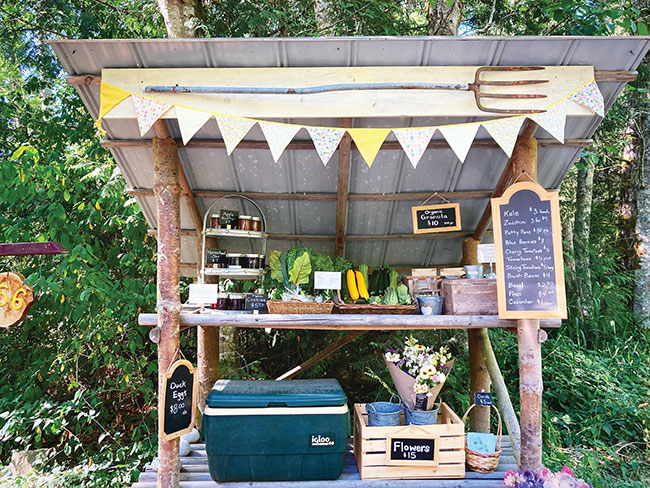
Features
Opinion
Cultivation
Legal
Supreme Court decision on home growing could have broader impact on industry
July 26, 2023 By Denis Gertler
 Salt Spring Island, B.C. Photo: Haley Nagasaki
Salt Spring Island, B.C. Photo: Haley Nagasaki I have a confession to make – I am a home grower. So, the Supreme Court of Canada’s recent decision to uphold the Quebec Court of Appeal’s ruling to effectively ban homegrown cannabis in the province caught my attention. Advocates of the practice in Quebec and Manitoba had been waging public relations and legal battles to push back on the efforts of their provincial governments to prohibit the pastime and its products, but they have now run out of legal options.
At first blush, this just seemed like an interesting side story. Then I wondered why Quebec was waging a war on growers. If it was fighting a protracted legal battle, were there broader implications? My first thought was, “how big is this group?” According to StatsCan, it’s about 10 per cent of Canadian cannabis users, excluding licensed medical home growers.
However, the 2022 Canadian Cannabis Survey found that 6 per cent of Canadians, or 14 per cent of those who had used cannabis in the past 12 months said plants had been grown “in or around their home.” Given the tendency to understate cannabis use, the actual figures could be greater. Overall, maybe two million Canadians are involved with home growing, so the Court’s decision affects a substantial number of users.
Unpacking that decision is instructive, too, because it suggests that other provinces could follow Quebec’s example with little need to provide a convincing rationale for policy change. Speaking for the Court in a unanimous decision, Chief Justice Wagner found that the “pith and substance” of Quebec’s law is that it was enacted to maintain the government’s monopoly to protect the public – especially children and youth – from the harms of cannabis use. According to the Justices, Quebec’s prohibitions are intended to steer users to the legal market where “the products offered, education on the risks of cannabis consumption and compliance with rules on the minimum age for purchasing cannabis” are state-controlled.
No evidence is needed on the efficacy of state policy since achieving these outcomes rests on the assumption that home growers will lay down their garden tools and flock to authorized retailers.
What the decision certainly does accomplish, though, is to re-criminalize home growing in Quebec and Manitoba. Apart from legal purchases, home growers in these jurisdictions have the choice of continuing their hobby illegally and face a fine, or to buy from illicit sources. This is happening at a bad time for Canada’s cannabis industry.
Price compression, oversupply, high taxes, and regulatory costs are triggering business closures and layoffs. One might think that the SCC’s decision provides a needed boost to LPs and retailers, but that’s unlikely. Cheap cannabis is qualitatively different from homegrown flower. People often grow cannabis because they enjoy the process as much as the crop.
The Court’s decision will not prompt home growers who embrace a do-it-yourself craft ethos, using living soil and organic inputs, to suddenly prefer store-bought weed. More likely, they will risk sanctions by continuing to grow at home, or they will buy illegal products. A recent study supports this line of thinking.
The research just published in The Journal of Studies on Alcohol and Drugs examines Canadian cannabis consumers with an eye to what is needed to engage them in the legal marketplace. The authors found that only 30 per cent of subjects appear to have their preferences met by legal sources. These consumers prefer pre-rolls over dried flower and consume less cannabis than other users. Another group who buy cannabis more frequently, are attracted by high THC potency and tend to favour illicit products.
A third group, representing 40 per cent of respondents, choose dried flower, seek packaging with detailed product information and appreciate freshness. People defined by these groups regard price differently, with those in the two cohorts least loyal to legal retailers willing to pay more for quality and high THC. Without reading too much into these findings, the results suggest weak allegiance to legal suppliers, with price not the only or even most important factor guiding buying decisions. The good news for legal suppliers is that respondents were willing to pay more for products regulated by Health Canada.
Industry leaders also question if lower prices increase profits, or whether these are doing more harm than good. Recent remarks at this year’s Lift Conference by Ontario Cannabis Store CEO David Lobo contend that the “race to the bottom” is compounding industry issues by squeezing margins, adding cost pressures, and not pulling enough traffic to keep authorized retailers afloat.
Meanwhile, the illicit market still comprises over 40 per cent of the consumer market according to the OCS’s own research, with other estimates stating its share is much greater. Lobo noted that such vulnerabilities expose the industry to future crises, perhaps a major recall due to adverse health effects. Making legal cannabis consumers sick would cancel the moral high ground claimed by the regulated industry, further weakening its position.
The last thing needed by a fragile cannabis sector is a resurgent illegal market augmented by disgruntled home growers. Suddenly 10 per cent doesn’t seem like such as small number.
Denis Gertler is a regulatory consultant, board member, and former government regulato
Print this page